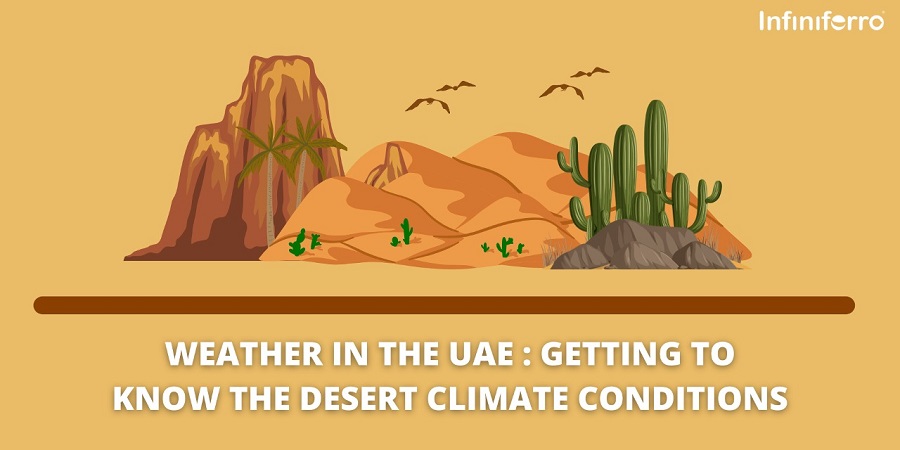
The United Arab Emirates (UAE) is known as a country with an arid desert climate and only has two seasons, namely summer and winter. The season is separated by two transition periods. The first transition period occurs from April to May and the second transition period occurs from October to November. Want to know more about climate and weather in UAE? Let’s discuss more deeply about what the climate and weather conditions are in the UAE.
Summer in the UAE: Scorching Heat!
Summer in the UAE usually runs from May to September. Temperatures during the day can jump up to 40°C to 50°C. On Friday, June 20, 2024, the highest temperature was recorded at 50.7°C at 12.45 p.m. in Sweihan, Abu Dhabi.
The first half of summer, generally characterized by dry weather with some strong winds blowing from the south. Then the second half is characterized by a sudden increase in air humidity, constant high temperatures, and humid Koi winds. This Koi wind is what causes thunderstorms after the wind encourages the formation of cumulonimbus clouds over the mountainous area and its surroundings.
This year’s heat wave in the UAE is more severe than the usual hot weather. High temperatures are common during the summer, but this heat wave is expected to break records in terms of duration and temperature. Heat waves occur because of a high-pressure system that traps warm air combined with a lack of clouds and the effects of urban heat from buildings.
The peak of the warm period begins around mid-July until the third week of August. The peak of this period will end marked by the rise of a star in the southern sky, the Suhail star. Symbolically, this phenomenon marks the end of extreme heat at the height of summer. In addition, it also marks the arrival of colder weather conditions.
This is the period when the weather really tests the body’s resistance to heat. When the temperature reaches 50°C, you will feel as if hot air is blowing from the oven directly on your face. If you stand in the sun without protection, within a few minutes you will be sweating profusely. Therefore, many people choose to spend most of their time indoors in an air-conditioned room to avoid this scorching heat.
Not only high temperatures, but the humidity in coastal areas such as Dubai and Abu Dhabi is also very high, making the weather feel hotter. This moisture comes from the ocean that surrounds the UAE. The closer you get to the coastline, the more moisture will be felt.
Then how do you live your days in this weather? No need to worry because air-conditioned facilities are very abundant in the UAE. Shopping malls, hotels, offices, and even bus stops are equipped with air conditioning. So, daily activities can still run smoothly and comfortably.
Winter in the UAE: Cool and Pleasant
Winter in the UAE usually begins around the first week of December or 100 days after the appearance of the star Suhail in August. This signals the start of the coldest phase with a drastic drop in temperature.
The winter solstice signifies the point at which one hemisphere is at its farthest angle from the sun. This phenomenon is recognized as the shortest day of the year due to the reduction of sunlight reaching the earth. This winter solstice usually occurs on December 21 or 22.
Meanwhile, the peak of winter occurs around mid-January. This period usually lasts for 10 days. At this time, the conditions become very cold with temperatures dropping to below 5°C, especially in mountainous areas.
Winter in the UAE is not like winter in other countries with colder climates. Here, winter means cool temperatures that are ideal for all sorts of outdoor activities. Many people use it to hold outdoor events, gather in parks and beaches, and camp in the desert to enjoy starry nights.
Rain in the UAE: Rare but refreshing

Although the weather in the UAE is predominantly hot and dry, there is also occasional rain. Rain usually occurs from December to February with sporadic rains. This means that there is no consistent rain pattern. However, when it rains it often comes in the form of short and intense rainstorms.
Since the infrastructure in some areas is not designed to handle heavy rainfall, this could lead to flooding in some areas. So, even though rain is a refreshing sight in this hot region, it could also cause disaster if a rainstorm suddenly appeared.
ALSO READ:
- What to know about the Dubai Rainwater Drainage System Project
- Take a Look at Manhole Covers in Abu Dhabi
- Look at Manhole Covers Installed in Dubai
Strong Winds and Sandstorms
Another weather element that often appears in the UAE is strong winds that usually bring sandstorms or dust storms. This sandstorm can interfere with visibility while driving. During sandstorms, it is recommended to stay indoors and close all doors and windows to avoid dust.
Conclusion
The weather in the UAE can indeed be a challenge for those who are not used to the desert climate. Summer with extreme high temperatures. The cool winters are suitable for a variety of outdoor activities. Meanwhile, rare rain can bring surprises because it occurs very briefly but intensely. Lastly, there are also strong winds that bring sandstorms.
Leave a Reply